Gadgets that wirelessly transmit audio from one place to another seem to be pretty popular these days. Case in point – the two reviews we recently posted here: the SoundCast OutCast Wireless Outdoor Speaker and the EOS Wireless Home Audio iPod Speaker System. The product I’d like to tell you about today has approximately the same features, but comes in a smaller package and seems to be marketed towards teens. It’s the i2i Stream from Aerielle.
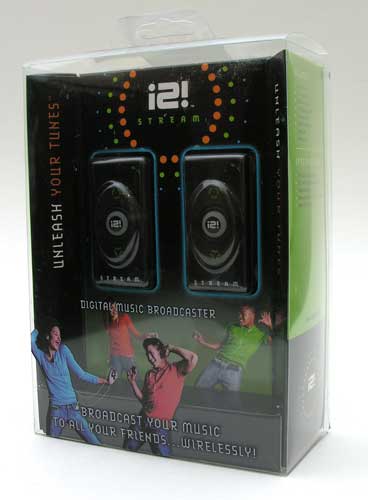
Hardware Specs
2.4 GHz Wireless Transceiver
CD Quality Audio (Uncompressed)
Wireless Range: 30 Feet
Rechargeable Battery (Charge via USB Cable)
Battery Life: 5-7 Hours
Frequency Response: 10Hz-24kHz
Bit Rate: 16bit @ 48ksps Stereo
Audio Latency:
SNR: > 75dB
THD: 0.007%
Stereo Separation: > 75dB
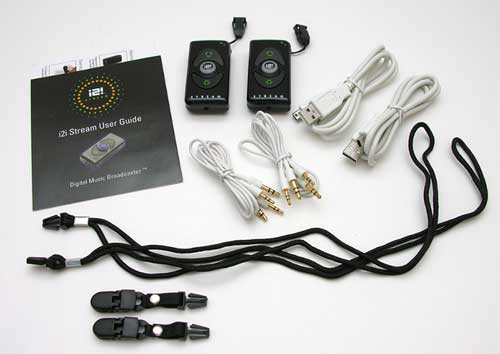
Package Contents
2 i2i Streams
2 12″ Audio cables
2 28″ Audio cables
2 USB charging cables
2 Pocket clips
2 Neck lanyards
User Guide
The i2i Stream is a small module that has both a receiver and a transmitter contained inside it, that operates on the 2.5GHz frequency. They are sold in packs of two for $119.95, or can be purchased separately at $69.95 each. I was sent one package of two for this review.
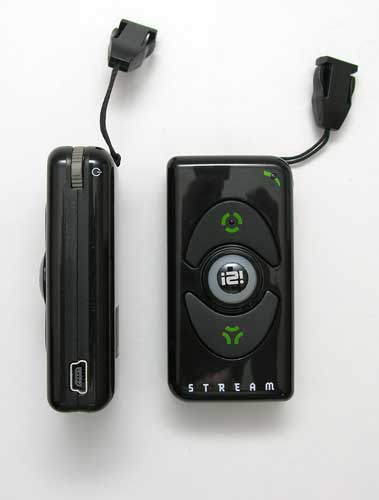
The modules are approximately 2.5 x 1.25 x 075 inches in size. On the face of the i2i Stream are three buttons and two LEDs. The round center button is the channel button. It has an LED behind it, that can glow Red, Orange, Yellow, Green, Blue, Purple or Light Blue. Each color signifies a different transmit channel and changes each time you press it. The button above the channel button is the Send button and the button below it is the Receive button. If you press the Send button, it will cause the center LED to blink, which shows that you’re broadcasting audio on whichever colored channel is blinking. Pressing the Receive button will cause the module to receive any audio that is being broadcast on whichever colored channel that you’re set to.
The Right side of the i2i has a mini USB connector that is used to charge the internal batteries. On the top corner, there is a spring loaded volume adjustment switch that doubles as the power switch. Hold the button in to toggle power, and rock it up and down to adjust volume.
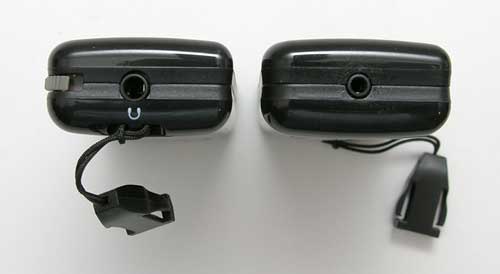
On the top edge of the module, there is a standard 3.5mm earphone jack and on the bottom there is a smaller 2.5mm jack.
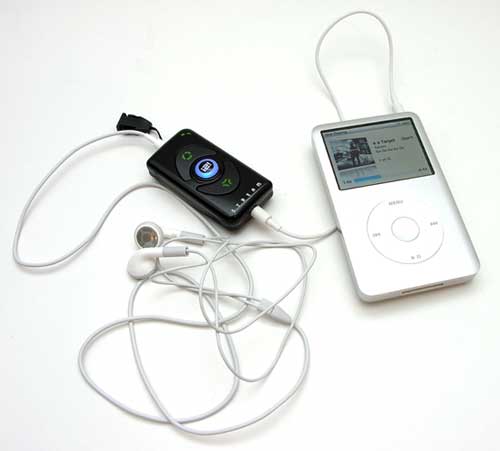
To use the i2i Stream, take one of the included audio cables and plug the 3.5mm end into the earphone jack of your audio device. Plug the other end of the cable (2.5mm) into the bottom of the i2i. Then plug in your favorite pair of headphones into the earphone jack on the i2i. From there, you can listen to you music normally without even turning on the i2i as it can be used as a pass through device. Of course, that’s not the point right? Turn on the i2i and pick a channel color. Then press the Send button. Take the second i2i module and plug another set of headphones into it. Turn it on and press the Receive button. Presto! You’re now listening to the music from other i2i. The receiving i2i doesn’t need to be connected to an audio player in order to receive music through connected headphones.
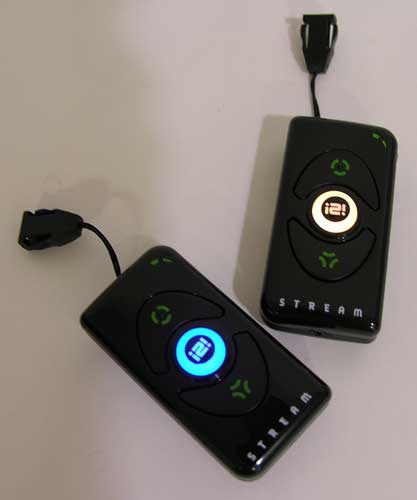
These modules have a 30ft range, which seems about right as I was able to test them by placing one i2i on one end of my house and walking to the other end. My house is about 32 feet long, and true to the 30 ft claim, the music would start cutting out when I had the maximum distance between the modules. Audio quality while in range seemed fine to me. I didn’t notice a huge difference in quality when listening through both i2i modules. Music through the receiving unit is slightly flatter sounding, but not significantly. I did notice a problem with volume levels though. I actually didn’t think one of my i2i modules was even working because I couldn’t receive audio through it. I finally realized that I had to crank up the volume to hear it. Then I noticed that increasing the volume on the sending module caused the receiving module’s volume to also increase. To me, that seems like a bad design due to the fact that you could actually harm someone’s hearing by cranking up the volume on the sending unit.
These i2i Streams have a one to many broadcast capability. You can send music to an unlimited number of modules within the 30 foot range. That said, only 3 transmitters may operate within 30 feet of each other, and only if they are transmitting on different channels. If the units are near a WiFi hotspot or other strong wireless network(s), it is possible that only 2 transmitters will be able to simultaneously operate within the 30 feet.
The i2i Stream is an interesting product, but it seems like it’s a bit more trouble than it’s worth due to the fact that you have to carry it around with the audio device that you wish to transmit from. There are extra wires involved, another device to keep charged, etc. It seems like if your friends really wanted to listen to your music that you could just hand them your player or connect it to a set of speakers and let them listen to it that way. I don’t really buy into the whole music sharing concept that the i2i is marketed for. I mean, do you have any friends that already have this gadget right now? I doubt it… However, I do think that there are alternative uses for this product that make more sense to me. For example, you could use it as a cheaper and easier to use alternative to the Audioengine W1 Premium Wireless Audio Adapter for transmitting audio from one device or laptop to speakers on the other side of the room. The only downside left would be the battery life, which is rated for only 5-7 hours. That seems kind of low in my opinion since most iPods and other players batteries last longer. I think I’ll pass on the i2i Stream. Let me know if you think otherwise…



Gadgeteer Comment Policy - Please read before commenting
Thanks for the review! I’ve been considering this product for use with a partner for ballroom dance practice on a crowded floor (usually, music other than what we need is being played from the sound system, and splitters for earbuds won’t work because of spinning, etc). But one thing troubles me: how noticeable is the latency? Would two people using these for dance be out of sync with each other? Thanks!
MJ:
I don’t think the latency will be noticeable at all.
Your idea for using this gadget is fantastic. How about I send them to you and you can see what you think?
Wow, thanks! That would be great! I will email you my information.
I bought a set of these for the same purpose as the other comment – ballroom dancing. It’s a great idea – but we have had a lot of issues with the receiver’s reception breaking up – to the point where the partner can’t hear enough of the song to keep up. Is this a cable issue? Can something be done about this? Also, I have to charge the units every time we use them, even if we have used them for less than an hour.
I have seen 2 couples ballroom dancing to the same music using an iPod with earphones and the other person using a receiver with earphones, so they are hearing the same song wirelessly. Neither couple can remember where they bought the devices. With this setup, a couple can dance anywhere listening to the same song and and nobody else can hear that music. I want one of these devices, but am not sure the above articles have described what I want. We want to dance without being connected by shared headphones or any other wires. We need to move away from each other for spins, etc.
I know this is a really old post, however, I thought I’d give you another use for them! I’m getting them so I can create my own wireless headphones for the tv. I want some regular, padded, big headphones for when I’m in bed relaxing, and earbuds so I can watch tv while running on the treadmill! These are a fantastic way to be able to switch between the two types of headphones! 🙂
@Kacie Thanks for the idea! I was trying to figure out a way to listen to TV while walking on the treadmill without having to turn up the volume really loud. 🙂